Soufrière St. Vincent April 13 2021 Eruption
The NOAA/CIMSS VOLCAT system is experimentally run at Space Science and Engineering Center (SSEC) at the University of Wisconsin using near real-time NOAA satellite data in support of volcano monitoring and forecasting. One data source available to VOLCAT is the GOES-16 Advanced Baseline Imager (ABI) data. GOES-16 ABI is providing frequent observations of the on-going eruption of the Soufrière St. Vincent volcano located on the island of St. Vincent in the Caribbean Sea. The GOES-16 ABI scans the Earth in different ways–one scanning method, the fulldisk scan, provides 10-minute refresh rate of data and covers the entire disk within view of GOES-16 ABI, another method known as a mesoscale scan, provides 1-minute refresh rate of data over a small region of Earth (approximately a 1,000 x 1,000 km box). VOLCAT is an artificial intelligence software suite that ingests satellite observations and other data to detect, characterize and track volcanic clouds and provide timely alerts to research partners (e.g., volcanic ash advisory centers, airlines, etc.) of new volcanic activity. The VOLCAT system has provided many alerts for the recent explosions from Soufrière St. Vincent. This blog post provides a detailed investigation of an explosion of Soufrière St. Vincent around 1030 UTC 13 April 2021 and compares VOLCAT alerts provided to research partners from the GOES-16 fulldisk and mesoscale scanning strategies.
Below are two VOLCAT alerts for a new explosion of Soufrière St. Vincent volcano around 1030 UTC 13 April 2021. The top image is a VOLCAT alert from the GOES-16 fulldisk scan strategy. The fulldisk scanning takes a bit less than 10 minutes to complete. Data is then processed through the VOLCAT algorithms and if an event is detected, an alert is issued. In this example, an alert for a volcanic Cumulonimbus (vCb) was issued at 10:41:43 UTC using the 10:30 UTC fulldisk observation. The bottom image is a VOLCAT alert from the GOES-16 mesoscale scan strategy. The mesoscale scanning takes less than 1 minute to complete and data processing is much faster due to the much smaller spatial domain. In this example, a vCb alert was issued at 10:37:15 UTC using the 10:36 UTC mesoscale observation.
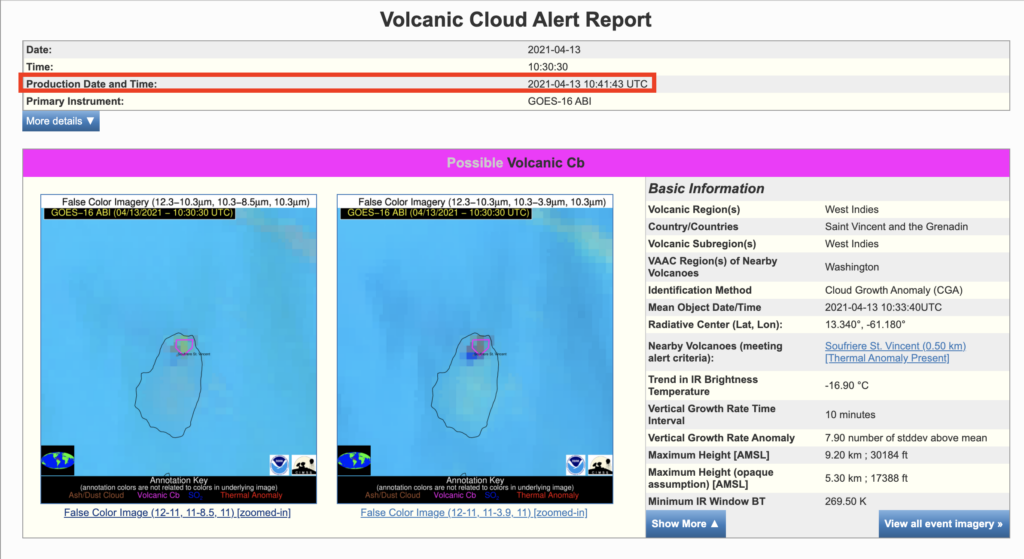
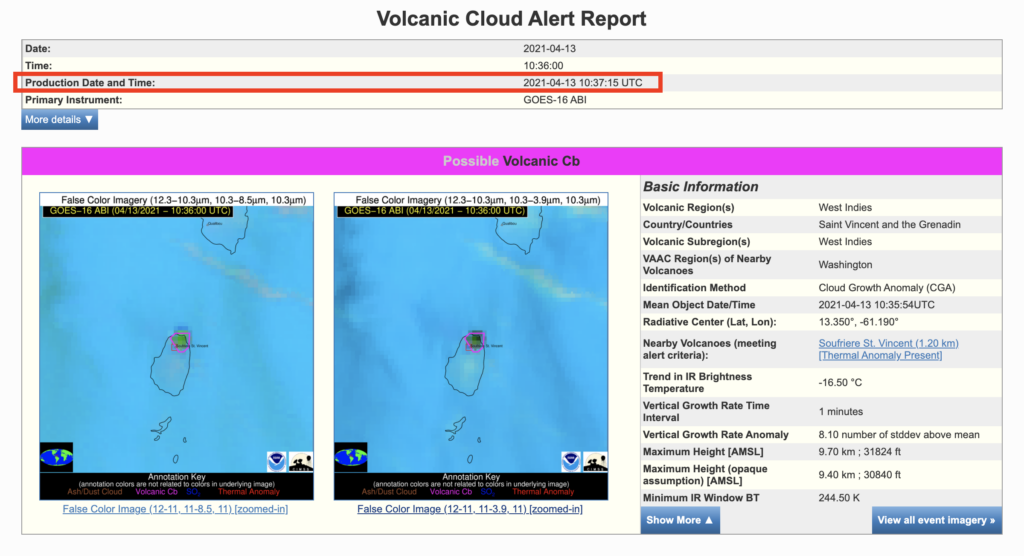
The VOLCAT system tracks clouds between satellite observations. For each satellite observation VOLCAT identifies a cloud object (in this case a cloud at the summit of Soufrière St. Vincent) and computes the minimum IR-window (10.3 µm, ABI channel 13) brightness temperature (BT) difference for the two observations. The difference between the two minimum BTs is computed over the time gap between the observations, yielding a cooling rate of the cloud. In this example, the fulldisk vCb alert was triggered on early stages of volcanic cloud growth between 1020 UTC and 1030 UTC (cooling rate of -16.9 K / 10 min), but due to the latency of fulldisk scanning, the alert was generated at 10:41:43 UTC. The mesoscale vCb alert was triggered by a more robust stage of volcanic cloud growth between 1035 and 1036 UTC (cooling rate of -16.5 K / 1 min), due to rapid scanning of mesoscale regions, the alert was issued at 10:37:15 UTC, less than 1 minute 30 seconds after the volcanic cloud was scanned by GOES-16 ABI. These examples highlight the utility of VOLCAT alerts to research partners and also highlight the utility of fulldisk scanning, specifically the ability to monitor volcanoes over the entire portion of Earth scanned by ABI. The utility of mesoscale scanning is also highlighted, specifically the ability to reduce latency significantly and measure extreme changes in cloud evolution over very short time periods.
Below we compare the VOLCAT vCb alerts to high resolution GOES-16 ABI visible imagery during this time period. The movie below shows extremely rapid growth of the Soufrière St. Vincent eruptive cloud using mesoscale sector visible imagery (0.64 µm, ABI channel 2) available from the CSPP GeoSphere website (https://geosphere.ssec.wisc.edu/). Due to the eruption occurring very shortly after local sunrise, one of the most interesting aspects beside the actual volcanic cloud, is the long shadow cast by the growing cloud. The shadow is to the left (west of the cloud).
Below are the two GOES-16 mesoscale IR-window (10.3 µm, channel 13) images with the cooling volcanic cloud highlighted in the red circles. The VOLCAT system automatically extracted the cooling BTs between these two images and resulted in the vCb alert shown previously.
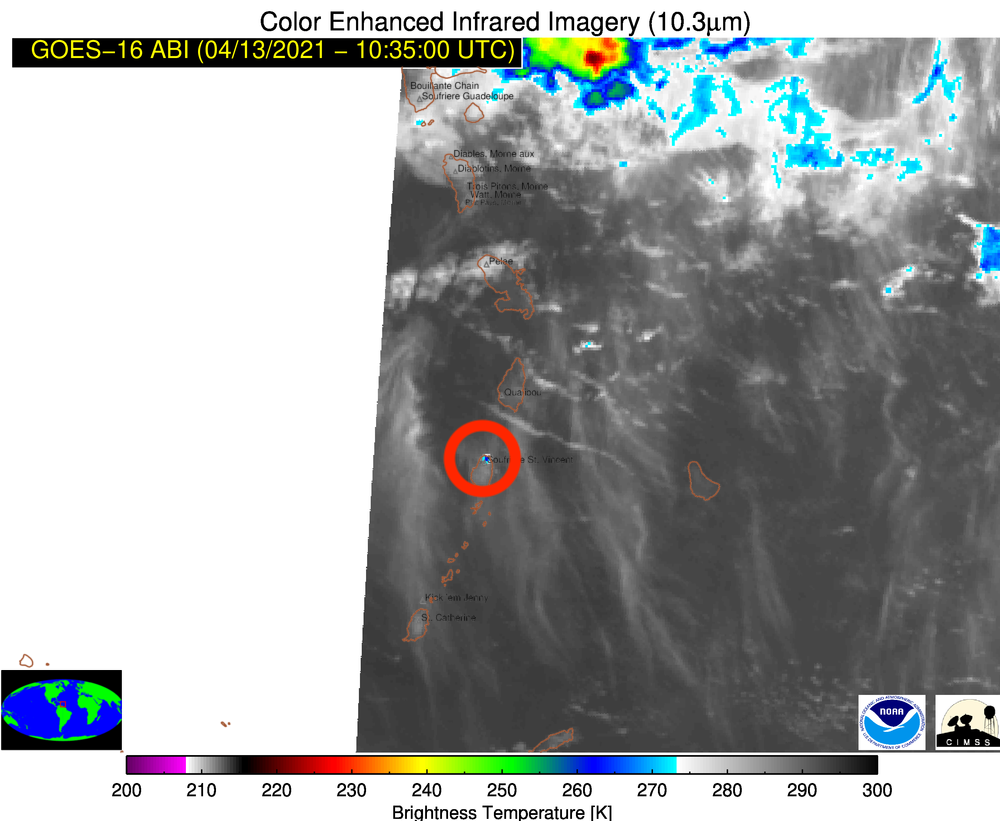
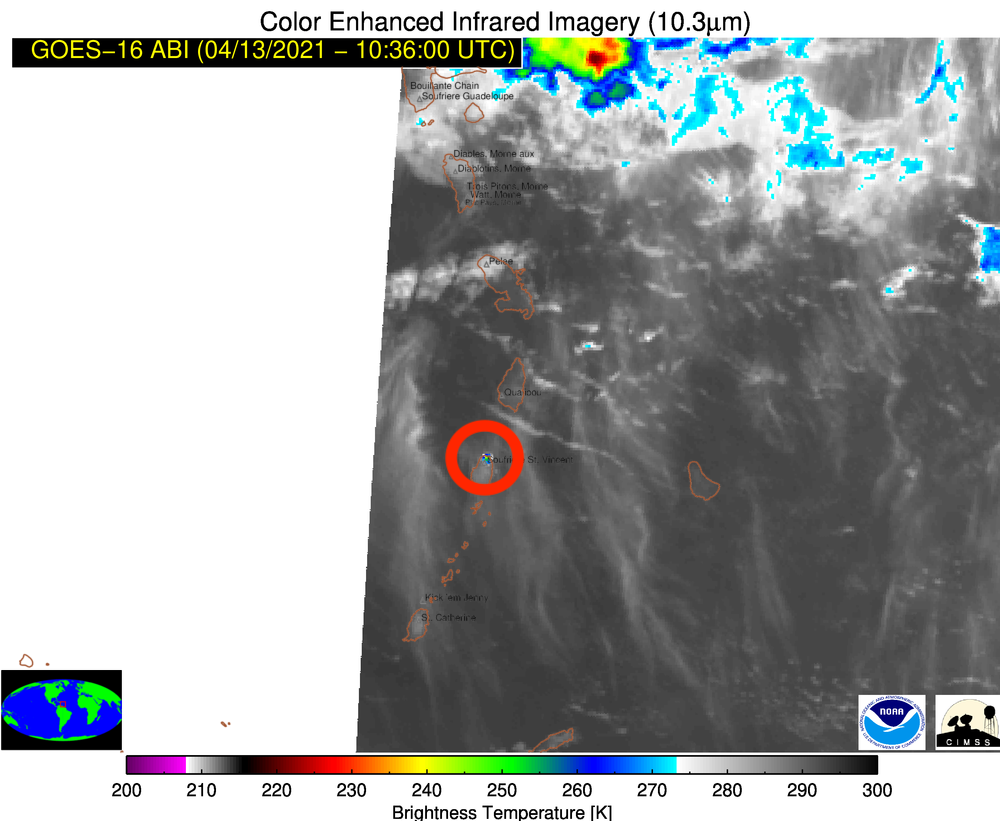
A similar set of images exists below from the GOES-16 fulldisk scan domain. The first image is the high resolution visible image at 1030 UTC from the CSSP GeoSphere imagery viewer. The shadow cast by the newly eruptive cloud is highlighted in the red circle. It is somewhat difficult to discern the cloud in the visible image, as it has grown vertically, but is still quite narrow; however the shadow makes this vertical growth much more obvious. The final two images are the two GOES-16 fulldisk IR-window (10.3 µm, channel 13) images with the cooling volcanic cloud highlighted in the red circles. The VOLCAT system automatically extracted the cooling BTs between these two images and resulted in the vCb alert shown previously.
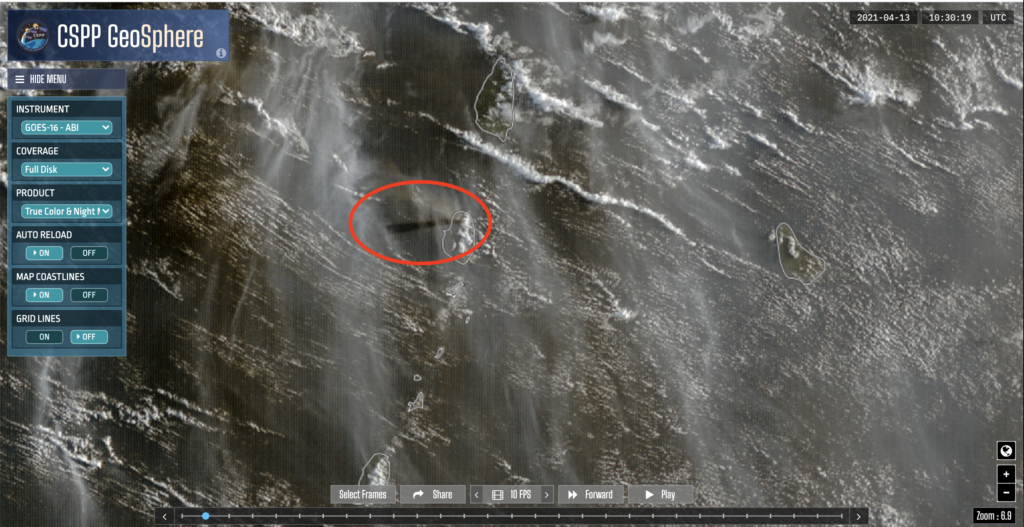
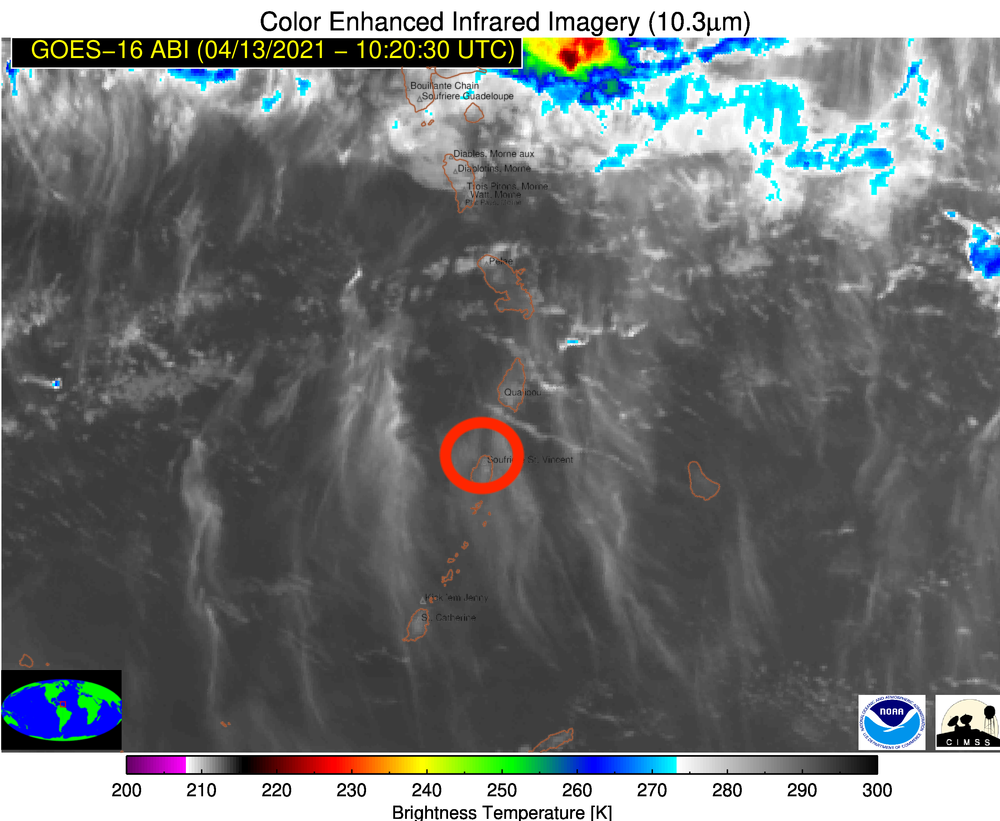
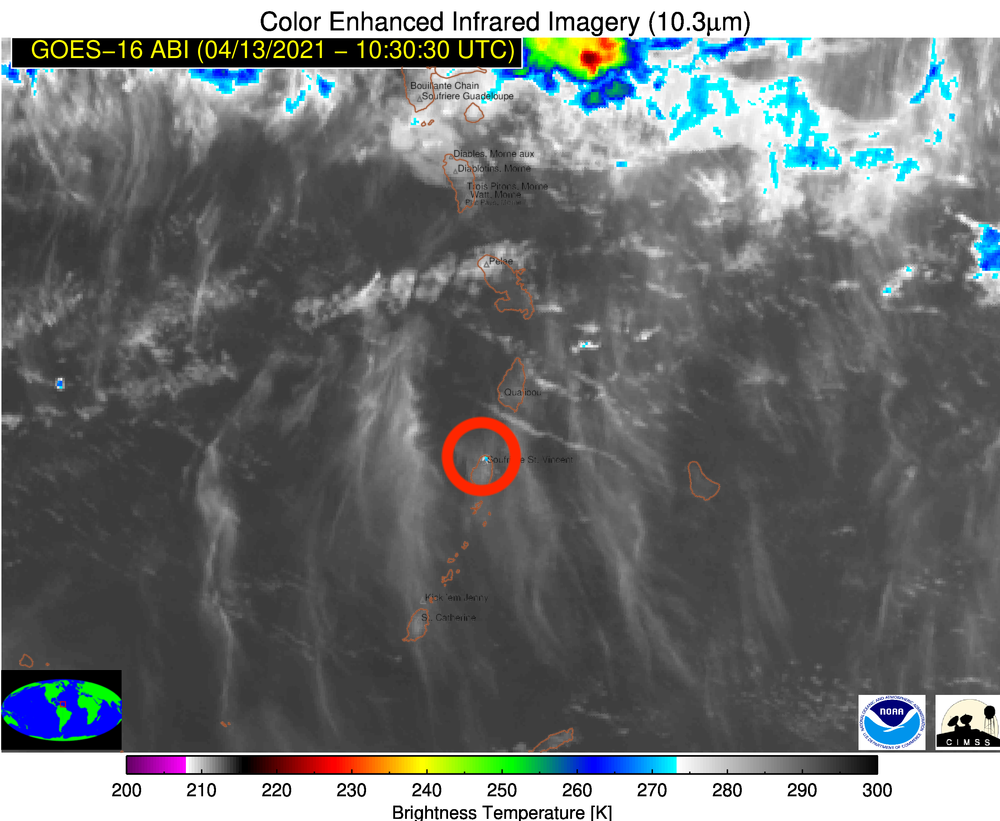
Summary
The VOLCAT system generated two vCb alerts for an explosion of the Soufrière St. Vincent volcano during the early morning hours (local time) 13 April 2021. The two vCb alerts were issued for the same eruptive event, but viewed by two different GOES-16 ABI scanning strategies–fulldisk and mesoscale. The fulldisk coverage in this example was able to diagnose very early cloud growth and issue a vCb alert from the 1030 UTC observation. The mesoscale coverage in this example was able to diagnose extremely rapid cloud growth and issue a vCb alert a short time later, from the 1036 UTC observation. The latency associated with fulldisk scanning resulted in the vCb fulldisk alert being issued after the alert from the mesoscale scanning (10:41:43 vs 10:37:15 UTC, respectively), despite an earlier observation time. This example highlights the ultra-low latency offered by the mesoscale scanning strategy (the vCb mesoscale alert was issued less than 1 minute and 30 seconds after the cloud observation), yet also highlights the capability of monitoring all volcanoes within the GOES-16 field of view offered by the fulldisk scanning strategy–both are important and can be used in a complimentary manner.
A careful analysis of the two vCb alerts may result in curious observation. The mesoscale vCb alert exhibited 16.5K cooling over 1 minute, which equated to “8.1 stand deviations above the mean”. The fulldisk vCb alert exhibited a 16.9K cooling over 10 minutes, which equated to “7.9 standard deviations above the mean”. The VOLCAT vCb algorithm translates the growth rates observed into number of standard deviations above the mean. The mean/standard deviations are from a large database of convectively active days over the annual cycle (meteorologically active, not volcanically active) which is binned as a function of background IR BT, pixel area (size) and observation time delta. In this example, the fulldisk vCb alert originated from a warmer background and over a much larger (10 min) time delta compared to the mesoscale region. Full details of the algorithm can be found in Pavolonis, Sieglaff, and Cintineo, 2018 “Automated Detection of Explosive Volcanic Eruptions Using Satellite‐Derived Cloud Vertical Growth Rates” (https://doi.org/10.1029/2018EA000410)